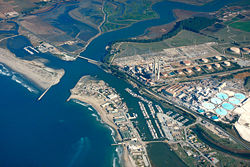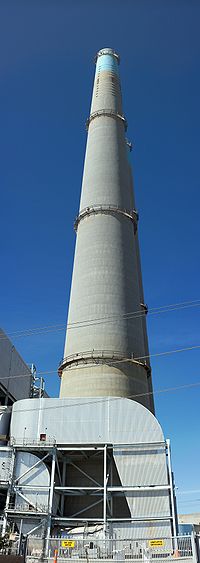
Moss Landing Power Plant
Encyclopedia



Electricity
Electricity is a general term encompassing a variety of phenomena resulting from the presence and flow of electric charge. These include many easily recognizable phenomena, such as lightning, static electricity, and the flow of electrical current in an electrical wire...
generation plant located in Moss Landing, California
Moss Landing, California
Moss Landing is a census-designated place in Monterey County, California, United States. Moss Landing is located on the Pajaro Valley Consolidated Railroad north-northeast of Monterey, at an elevation of 10 feet . As of the 2010 census, the CDP population was 204, down from 300 at the 2000...
, at the midpoint of Monterey Bay
Monterey Bay
Monterey Bay is a bay of the Pacific Ocean, along the central coast of California. The bay is south of San Francisco and San Jose, between the cities of Santa Cruz and Monterey....
. The plant's large stack
Chimney
A chimney is a structure for venting hot flue gases or smoke from a boiler, stove, furnace or fireplace to the outside atmosphere. Chimneys are typically vertical, or as near as possible to vertical, to ensure that the gases flow smoothly, drawing air into the combustion in what is known as the...
s are landmarks, visible throughout the Monterey Bay Area.
History
The building of the Moss Landing power plant began in 1949 with the first five units. Producing 560 MW, these units started commercial generation in 1950. After 45 years of production, the original five units were decommissioned in 1995.In 1964, the construction of two additional units began (6 and 7), with two new 500 feet (152.4 m) stacks. These two units produce 750 MW each, with boilers that are 180 feet (54.9 m) tall. They employ a newer technology using supercritical steam
Supercritical fluid
A supercritical fluid is any substance at a temperature and pressure above its critical point, where distinct liquid and gas phases do not exist. It can effuse through solids like a gas, and dissolve materials like a liquid...
at 3600 psi (24.8 MPa).
The generation process for units 6 and 7 starts with natural gas injected at one end of the boiler to be burned. Primary water is injected at the other end of the boiler to receive the heat produced. The gas simply comes from a natural gas pipeline, and combustion products go up the stack and into the atmosphere.
Water has a much more complicated path, and consists of two distinct systems: coolant water and primary (steam-generating) water. Cooling water is pumped out of the Monterey Bay or the nearby Elkhorn Slough
Elkhorn Slough
Elkhorn Slough is a tidal slough and estuary on Monterey Bay in Monterey County, California. The community of Moss Landing and the huge Moss Landing Power Plant are located at the mouth of the slough on the bay....
. Then it is purified, used to cool down the water coming from the turbines, and discharged into the ocean. Steam for the turbines is created from the primary water flow, which is preheated before entering the boiler. From the boiler, the superheated steam is directed into a first turbine
Turbine
A turbine is a rotary engine that extracts energy from a fluid flow and converts it into useful work.The simplest turbines have one moving part, a rotor assembly, which is a shaft or drum with blades attached. Moving fluid acts on the blades, or the blades react to the flow, so that they move and...
working at high pressure, then into a low pressure turbine. The turbines drive the generators.
To comply with more restrictive pollution regulation, units 6 and 7 were upgraded in 1998 with a selective catalytic reduction
Selective catalytic reduction
Selective catalytic reduction is a means of converting nitrogen oxides, also referred to as with the aid of a catalyst into diatomic nitrogen , , and water, . A gaseous reductant, typically anhydrous ammonia, aqueous ammonia or urea, is added to a stream of flue or exhaust gas and is absorbed...
unit and digital control systems.
Starting in 2000, the eight 225 feet (68.6 m) stacks and 19 fuel oil storage tanks were removed, and two new units were built on the former site. The new units 1 and 2 were brought online in 2002. They are combined cycle
Combined cycle
In electric power generation a combined cycle is an assembly of heat engines that work in tandem off the same source of heat, converting it into mechanical energy, which in turn usually drives electrical generators...
units, 50% more efficient than the other units. because they use two turbines: first, a pair of 170 MW gas turbines, then a 190 MW steam turbine, for a total of 530 MW each.
Combustion products drive the gas turbines directly. First, air is drawn from the air intake to the compressor (driven by the turbine axle), then it is burned with natural gas in the combustion chamber. The hot combustion gasses then go through the actual turbine (driving the axle). From a thermodynamic standpoint, this is the standard Brayton cycle
Brayton cycle
The Brayton cycle is a thermodynamic cycle that describes the workings of the gas turbine engine, basis of the airbreathing jet engine and others. It is named after George Brayton , the American engineer who developed it, although it was originally proposed and patented by Englishman John Barber...
. Because the gas turbine does not transfer energy from the combustion process to the turbine via steam, it avoids the cost, energy loss and environmental impact of the primary water cycle.
At the output of the gas turbines, some of the remaining energy (heat) in the exhaust gas is recovered through a heat exchanger and transferred to water that feeds a steam turbine, similar to units 6 and 7.
On a smaller scale than the supercritical units, units 1 and 2 are also more flexible, with a start-up time of only an hour, against 24 hours for units 6 and 7.
The Moss Landing power plant has a maximum capacity of 2560 MW, but the older, less efficient, supercritical units 6 and 7 are only operated during the peak period between June and September.
Some of the power generated from the plant is sent to far-away regions via Path 15
Path 15
Path 15 is an portion of the north-south power transmission corridor in California, U.S. It forms a part of the Pacific AC Intertie and the California-Oregon Transmission Project....
, directly connected to the plant, and interconnections like Path 26
Path 26
Path 26 is a set of three Southern California Edison 500 kV power lines, located primarily in Los Angeles County, and extending into Kern and Ventura Counties, all in California...
and Path 66
Path 66
Path 66 is the name of several 500 kV power lines that were built by Western Area Power Administration , Pacific Gas & Electric , and PacifiCorp in the early 1970s to 1990s and totally completed in 1993...
.
The Moss Landing power plant was built and owned by Pacific Gas & Electric. As part of California's experiment with energy deregulation
California electricity crisis
The California electricity crisis, also known as the Western U.S. Energy Crisis of 2000 and 2001 was a situation in which California had a shortage of electricity caused by market manipulations and illegal shutdowns of pipelines by Texas energy consortiums...
, PG&E sold it to Duke Energy
Duke Energy
Duke Energy , headquartered in Charlotte, North Carolina, is an energy company with assets in the United States, Canada and Latin America.-Overview:...
(DENA) in 1998. In 2006, having invested over half a billion dollars in upgraded capacity, efficiency and emission control, Duke Energy sold the plant to LS Power Equity Partners.
Dynegy
Dynegy
Dynegy Inc. , based in Houston, Texas, United States, is a large owner and operator of power plants and a player in the natural gas liquids and coal business...
of Houston, Texas
Houston, Texas
Houston is the fourth-largest city in the United States, and the largest city in the state of Texas. According to the 2010 U.S. Census, the city had a population of 2.1 million people within an area of . Houston is the seat of Harris County and the economic center of , which is the ...
then purchased the plant in April 2007 along with other assets of LS partners.
Each day, roughly 1200000000 gallons (4,542,494.4 m³) of water are cycled through the power plant.
Cultural significance
The name of the Cloud Factory, a music and arts community which founded the ChillitsChillits
Chillits is an exclusive annual ambient music festival held every September from 1999 through 2009 at a private retreat center near Willits, California, USA and at an alternate location starting in 2010. There is one main sound stage, with music playing almost continuously through the weekend by...
festival, was inspired by the Moss Landing Power Plant.

